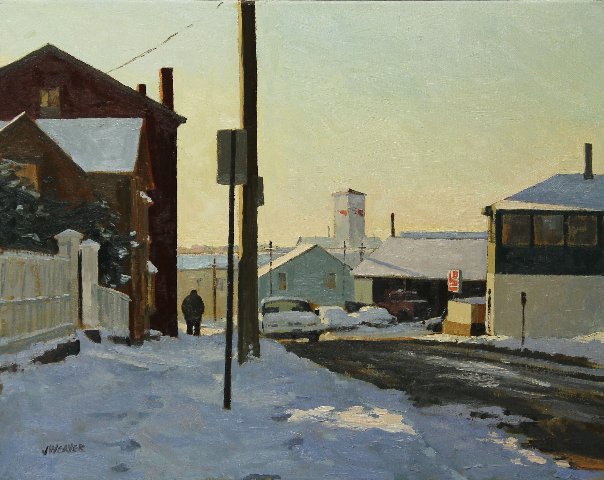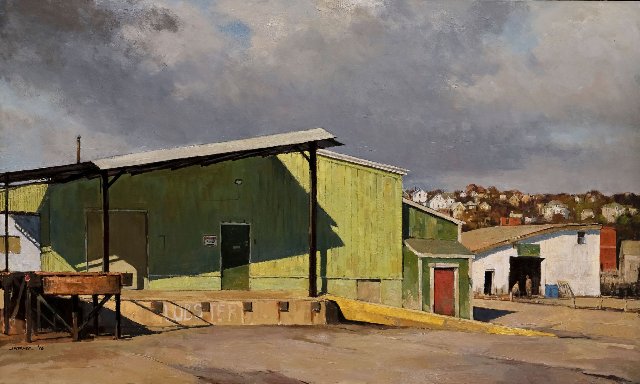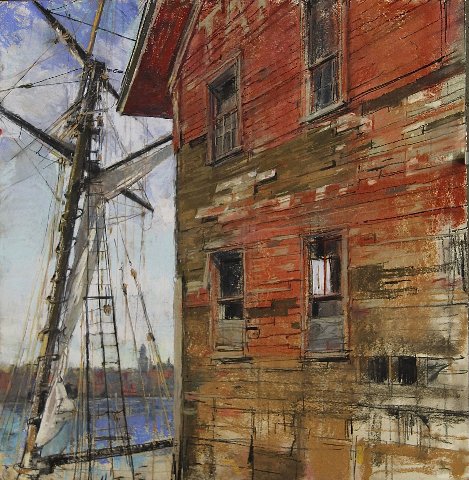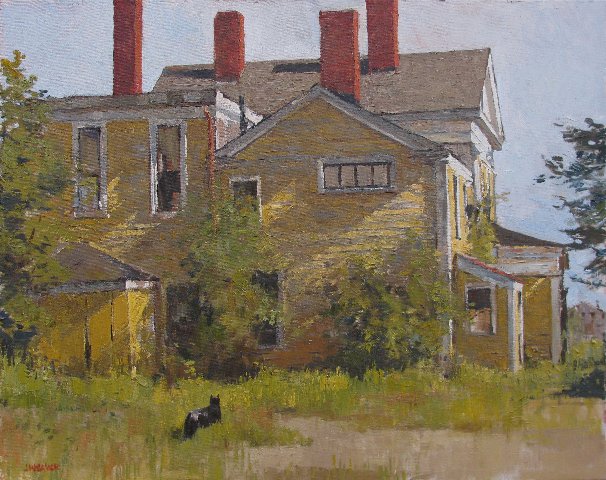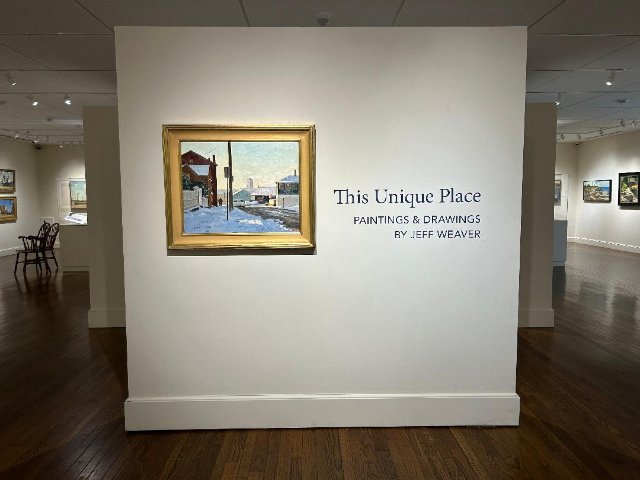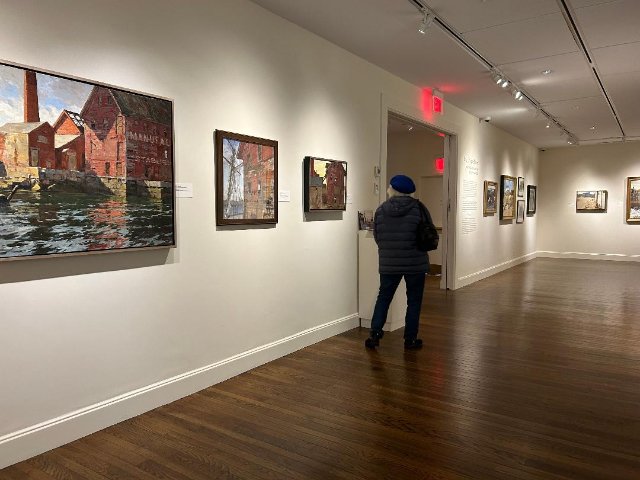This Unique Place: Paintings and Drawings of Jeff Weaver
Stunning Exhibition at Cape Ann Museum
By: Charles Giuliano - May 21, 2023
Europeans settled in Le Beau Port in 1623 renaming it Gloucester. The programming of Gloucester 400th Plus acknowledges millennia of indigenous people, primarily the Pawtucket, who “went silent.”
For this occasion the Cape Ann Museum has programmed a stunning year of special exhibitions. In 1923 Edward Hopper painted in Gloucester where he met and later married the artist Josephine Nivison. There is much anticipation for the landmark exhibition which celebrates them opening in late July.
In collaboration with the Whitney Museum of American Art, Oliver Barker, director of CAM told me during a recent visit that “It is the greatest single exhibition mounted by the museum in its history.”
Certainly overshadowed is the spectacular prequel This Unique Place: Paintings and Drawings of Jeff Weaver, curated by Martha Oaks, which deserves equal billing.
Arguably, Weaver, a meticulous realist, is technically the better painter, while the more imaginative Hopper, is unquestionably the greater artist. It is savvy programming for the museum to present these masters back to back.
The richly varied topography of Cape Ann, starting in the 19th century with Fitz Henry Lane and Winslow Homer, has consistently lured many of the greatest American artists to live and work there. While Weaver continues this tradition his riveting paintings compare well to the best of his predecessors.
It is poignant and ominous that he is the penultimate painter to document the last gasp of Gloucester as we have known and loved it. Like Hopper he is fascinated by the quotidian, generic, residential and commercial architecture of a once thriving fishing industry.
While he focuses on the fishermen’s homes in the waterfront Fort and Portuguese Hill, or the processing plants and warehouses of the docks, the paintings represent the old Gloucester. In the past few decades, starting with the development of Nugent Farm, condos have sprung up on every vacant patch of land with no end in sight.
What Weaver so painstakingly renders are the indigenous, vernacular structures that were pragmatic and seemingly devoid of style and design. It is the kind of “non architecture” that is easily ignored or underappreciated. That’s no longer an option once we are Weavered.
The artist is a plein air painter. A vitrine displays his sketch pads and pastels. An image is worked up in an elaborate process. His primary concern entails the precise play of light picking up the texture of weathered surfaces. The paintings can only truly be appreciated when standing before them. This is work that does not reproduce adequately. The museum has produced a well illustrated catalogue with an essay by Oaks and brief comments by the artist, Barker, Ernst von Metzsch, and Don Gorvett. Regarding the color plates, however, they ain’t nothin’ like the real thing baby.
As a painter Weaver is a man for all seasons. Some of the most engaging works are winter scenes. It’s the Gloucester that tourists never see.
We stood next to an older native visitor as she toured the exhibition. Looking over her shoulder we viewed a harbor scene painted in East Gloucester looking toward the baroque tower of Town Hall. The water was flat and slate gray in the subdued light. “That’s just what it looks like in winter,” she exclaimed in wonder.
The scale varies from many small “portraits” of single houses, to broad panoramas of commercial buildings, to monumental minimalist renderings that evoke stark, modernist abstractions.
Like Atget’s early morning photographs of Paris the paintings are generally unpopulated. Here and there we find a bundled up figure trudging along a snow packed lane. Just such a picture Tully’s Corner, 2003 is both the cover of the catalogue and single work for the signage wall that welcomes visitors.
A signifier of Cape Ann is granite whose quarries were the other industry. That collapsed when construction morphed from granite to concrete after WWII. Weaver rightly pays homage to this signifier in Shed and Sea Wall, Hodgkin’s Cove, 2020, and Quarry Remnants, 2019.
Often the artist positions his easel at odd and dramatic angles to his subject. Beach Hotel Off Season, 2021, is a quirky end view of the structure which looms over a generic slab of concrete wall. Seen from below in Tea House, 2018, we look up over an incline of rough boulders and granite wall at a cropped white house under a brilliant sky. Intruding from the right edge is a slice of a roofed granite structure.
The once dominant fishing industry has been reduced to a few vessels. Locals can still buy lobster and scallops from boats off the dock. Weaver’s depictions of vessels and warehouses record the remnants of Captain’s Courageous. His greatest gift is to capture the decay of structures and their dazzling reflections in still harbor water.
We stood transfixed before an epic Working Waterfront, 2020, the monumental simplicity of Harbor Dock, 2017, shimmering Reflections of Seawall, 2016, sublime Paint Factory, Afternoon Reflections, 2019, and the utterly smashing, Beacon in Spring, 2017.
A norm of the work is that it resists anecdote and narrative. Works like Tops’l Schooner at Manufactory. 2020, or Paint Factory in Winter, 2014, transfix us with their textures of benign neglect. Our eyes revel in scanning over their battered surfaces.
The exception that proves the rule is In Burnham Field, 2021. It’s as if the artist can’t help himself breaking down his objective, self imposed austerity. In the foreground we hilariously encounter two silly snowmen with a row of houses in the distance. Here, indeed, the picture tells a rollicking story.
The triumphant work, and most likely to be sought after by collectors and museums, entails stark, monumental, reductive geometry. The flat, dull catalogue reproduction does disservice to the masterpiece Blue Shed, 2022. Here the “narrative” is reduced to a single flat wall of a shed shimmering in the harbor below it. Others of its ilk are Green Factory Wall, 2018 and Americold Series #1, 2021.
Significantly, what’s missing in this exhibition are depictions of blasphemous, hideous, Home Depot condos.

